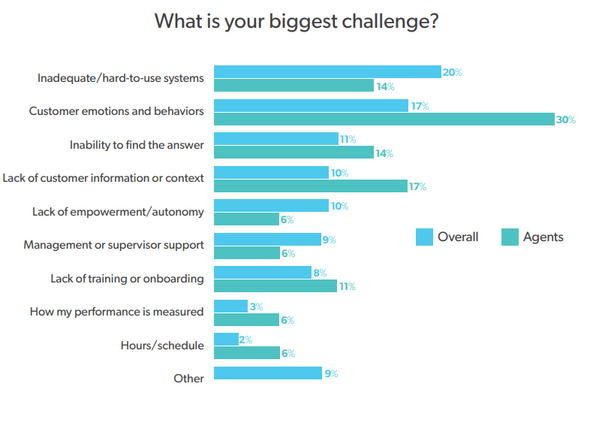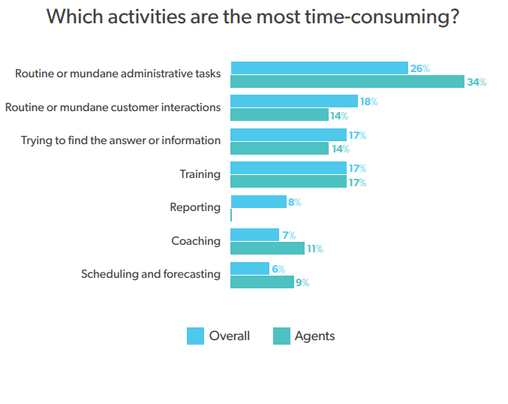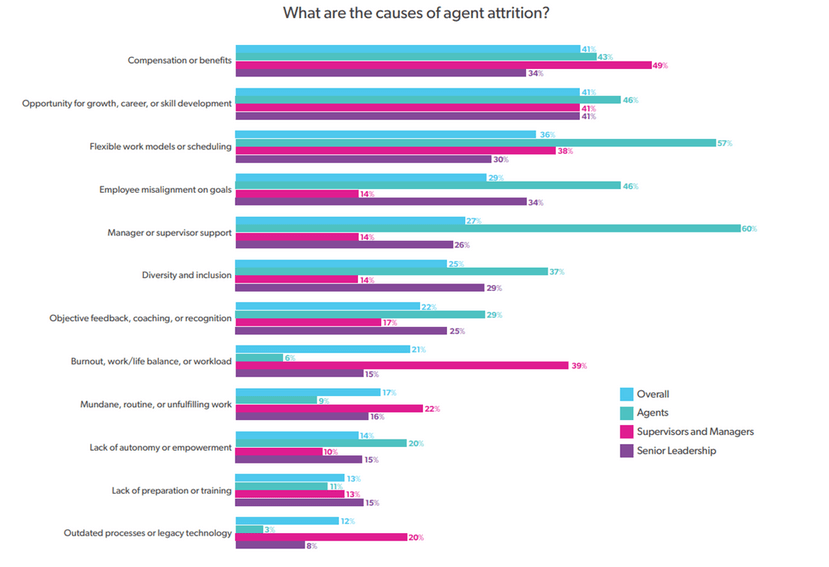By
Jennifer Wilson
|
Date Published: September 01, 2022 - Last Updated August 29, 2022
|
Comments
An IndustryVoices article
Job satisfaction is up for contact center agents, but that may not be enough.
Take a look at any contact center company page. Chances are, you’ll be inundated with content surrounding the customer experience (CX). And rightfully so—positive experiences are the drivers behind business growth and brand loyalty. But too often, even as talk of “The Great Resignation” has ignited the conversation around the employee experience, contact center agents come second to the customers they’re tasked with serving.
This critical mistake ignores one categorical truth: AX (agent experience) is at the center of CX.
In May 2022, NICE CXone partnered with ICMI to explore the current state of the agent experience. Read on for highlights of the report’s most important findings, and learn how contact center leaders can prioritize their most indispensable resource.
Survey highlights
In this post-pandemic follow up to ICMI’s 2019 State of Agent Experience and Engagement, we found that contact centers are hiring more agents, implementing new channels and tools to handle increased volume, and supporting factors that lead to job satisfaction. But that doesn’t paint the whole picture. Agents’ expectations are rising, and they’re clear about the sources of friction in their jobs.
Some of their pain points include:
- Challenges around customer emotions and behaviors and lack of information and context
- Routine or mundane administrative tasks and inadequate or hard-to-use systems
- Inflexible work models, lack of manager support, and insufficient growth opportunities
These are obstacles that must be removed if contact centers want to attract and retain top talent. And this doesn’t just apply to agents. Managers and supervisors aren’t supporting their teams as well as they should—which is the leading cause of attrition, according to 64% of the agents polled. Leaders must look at their entire workforce, enhance their experiences, and live up to the opportunities that can (and should) be cultivated in a post-pandemic business world.
Improving customer-agent interactions
Generally speaking, the agent’s experience isn’t at the top of a customer’s priority list when they reach out for support—they simply want to resolve their issue. This means that any friction in their journey (e.g., not finding the right answers online, having to repeat information at various touchpoints, etc.) often leads to unnecessary frustration with the agents supporting them.
However, contact centers are uniquely positioned to eliminate many of those frustrations before an escalation to an agent, and mitigate many more that remain during and after it.

The two biggest—albeit solvable—challenges contact center agents face are customer emotions and behaviors (30%) and lack of customer information or context (17%). Let’s take these one by one to uncover how to eliminate and mitigate frustrations that stem from them:
1) Customer emotions and behaviors: Agents usually recognize overtly angry customers, but it’s not as easy when tempers slowly flair up. AI-powered sentiment measuring on the agent desktop can automatically detect when a particular soft skill is needed and prompt the agent accordingly (for example, a screen pop to use more empathetic language). Rather than being the subject of a customer tirade, the agent can steer the interaction to resolution—the place it was meant to go in the first place.
2) Lack of information or context: When customers are forced to repeat their information at multiple touchpoints (e.g., first in a form fill, then with a chatbot, and then with an agent), it adds unnecessary time and frustration to their journey. With a unified cloud-based contact center platform, customer information and history follows them throughout their journey, eliminating customer friction and providing invaluable context to the agent in the event of an escalation.
Delivering in-the-moment coaching while cutting down on friction along the customer journey should be two actionable priorities for contact center leaders. Those processes improve interactions, mitigate customer frustrations, and eliminate the two biggest challenges for agents.
Optimizing day-to-day responsibilities
While improving customer-agent interactions is by far the most effective way to remove daily challenges, it’s not the only thing that enhances the agent experience. Our survey found that helping customers was the aspect agents like most about working in customer service, but that routine or mundane administrative tasks are the most time-consuming part of their jobs.
Furthermore, agents often scramble to find the right answers when they’re interacting with a customer, while navigating multiple inadequate or hard-to-use systems. These challenges—coupled with after-call work (ACW) and other repetitive aspects of their jobs—prevent agents from doing the work they find most impactful and fulfilling.

As contact center leaders continue to prioritize the agent experience, free snacks and cool break rooms are simply not good enough to keep agents around for the long haul. Here are a few ways you can begin to improve agents’ day-to-days:
1) Automate mundane tasks: Tools like robotic process automation (RPA) take over rules-based processes, cutting down on ACW and enabling agents to dedicate their time to their customers.
2) Unify your systems: A cloud-based contact center solution unifies disparate systems and applications, so agents no longer have to click through multiple systems to effectively perform their jobs.
3) Deliver knowledge proactively: A strong knowledge management platform extends the right answers at any point on the customer journey, deflecting many routine interactions and leaving agents to handle meaningful ones more effectively.
Agents say that fulfilling work has the greatest impact on their engagement (26%), even over successful performance (17%) and understanding of their jobs and goals (23%). By improving processes so that agents’ jobs are more fulfilling, your contact center will see more engagement and satisfaction.
Prioritizing agent needs and expectations
Making agents’ day-to-day work life more fulfilling is just part of improving the agent experience. Agents are looking for career growth, flexible and remote work models, and better manager or supervisor support. In fact, each of those reasons are higher causes of attrition for agents than simply wanting higher-paying jobs.

Most of today’s contact centers recognize their need to support remote or hybrid-model options for their agents. And while remote work certainly adds to high satisfaction, schedule flexibility is far more important to agents. Agents don’t just want to work in their preferred space, but during the times they work most effectively.
Accurate forecasting goes a long way to accommodating and supporting agent flexibility, and it helps ensure meaningful work with minimal downtime when they’re on the clock. This also requires a high level of support by their managers and supervisors, while being given room and opportunity to grow. Here are some of the ways you can truly respect and support your agents’ time:
Workforce management: Fully remote, in-office, or hybrid jobs can be equally managed and quality-assured through intelligent . It keeps agents engaged while accurately hitting service level agreements and scaling as needed.
Personalized coaching: Both new and seasoned agents need coaching—and because everyone learns best differently, you should tailor it to their preferred style. Personalized, bite-size training proactively instructs agents on your products and services as well as their own interpersonal skills.
Learning and development: 90% of agents say being able to support multiple channels is a beneficial career move, and 46% leave their jobs for skill-development opportunities elsewhere. Investing in your agents’ growth and skillset leads to higher engagement and lower attrition.
There’s plenty of evidence to suggest that contact centers are prioritizing the agent experience. Our study shows that there are higher levels of job satisfaction, increased career opportunities, and less attrition than before the pandemic. This is (and should be) encouraging for leaders.
But as the highlights above reveal, there’s plenty of work ahead to keep that trajectory on pace. Agent expectations have increased significantly in recent years, and are likely to continue at an accelerated clip. If leaders don’t match—and exceed—their evolving expectations, current levels of satisfaction will not persist.
How you treat your agents is how they’ll treat your customers. That much is clear. And while most contact centers are rethinking their AX in order to attract and retain talent, the margin for error is smaller than leaders think. Your agents won’t hesitate to leave your organization for better support and opportunities, just as customers will leave after negative experiences.
But your agents are clear about the things that will keep them around longer. Start improving interactions, optimizing their work, and prioritizing their development. They’ll thank you with their loyalty—and your customers aren’t likely to complain, either.
Read the full ICMI and NICE report